

Name: Eureka Year: 2011 Client: POLIMI Categories: Product Authors: Vasyl Pavlyuchok
Name: Eureka Year: 2011 Client: POLIMI Categories: Product Authors: Vasyl Pavlyuchok
Overview ——
Eureka is a quite characteristic scale that works using water. Designed to claim traditional methods of measurement, this object is a perfect complement for your kitchen.
Overview ——
Eureka is a quite characteristic scale that works using water. Designed to claim traditional methods of measurement, this object is a perfect complement for your kitchen.


Nowadays, modern scales have become high-tech devices. They are capable of providing very accurate data, however, many other traditional systems had been used over millennia.
Brief ——
Nowadays, modern scales have become high-tech devices. They are capable of providing very accurate data, however, many other traditional systems had been used over millennia.
Brief ——
First scales date back to around 2 000 B.C. when during the development of trade in ancient Egypt, merchants needed a way to measure the value of goods they sold. Those first weighing scales were actually balances, using two plates attached to an overhead beam, fixed itself on a central pole. Since then the scales have undergone infinite changes and improvements. Today, there are many types of scales that vary according to their shape, products to weigh, size and state of the products, and physical principle they are based on. The main problem here is that digital scales are replacing the traditional ones. Notwithstanding these scales have been used for several millennia, this is leading them to be cast into oblivion.
As a solution, it has been proposed to redesign the traditional scale, to reclaim the use of scales based on traditional systems. The main links to consider were to create a modern scale, based on any traditional system that could be used at home.
First scales date back to around 2 000 B.C. when during the development of trade in ancient Egypt, merchants needed a way to measure the value of goods they sold. Those first weighing scales were actually balances, using two plates attached to an overhead beam, fixed itself on a central pole. Since then the scales have undergone infinite changes and improvements. Today, there are many types of scales that vary according to their shape, products to weigh, size and state of the products, and physical principle they are based on. The main problem here is that digital scales are replacing the traditional ones. Notwithstanding these scales have been used for several millennia, this is leading them to be cast into oblivion.
As a solution, it has been proposed to redesign the traditional scale, to reclaim the use of scales based on traditional systems. The main links to consider were to create a modern scale, based on any traditional system that could be used at home.


One of the most ancient scales (balance) found. 15th c. BCE. Vapheio tholos tomb, Laconia. National Museum, Athens.


One of the most ancient scales (balance) found. 15th c. BCE. Vapheio tholos tomb, Laconia. National Museum, Athens.
Research ——
According to the Cambridge dictionary, “weighing scale is a device for weighing things or people.” To proceed with this part, it was required to analyze different types of scales that exist and then to understand what weighing principles they are based on.
The operation of the scales is based on different physical principles, capable of measuring mass, force exertion or tensional resistance. Mechanical scales work without the need of a power supply (balance scale, spring scale, pendulum, hydraulic or pneumatic scales). On the other hand, a digital scale combines a mechanical process (the force of the weight causes a spring to deform), with an electric current, which is applied to one or more transducers able to measure the amount of deformation.
Research ——
According to the Cambridge dictionary, “weighing scale is a device for weighing things or people.” To proceed with this part, it was required to analyze different types of scales that exist and then to understand what weighing principles they are based on.
The operation of the scales is based on different physical principles, capable of measuring mass, force exertion or tensional resistance. Mechanical scales work without the need of a power supply (balance scale, spring scale, pendulum, hydraulic or pneumatic scales). On the other hand, a digital scale combines a mechanical process (the force of the weight causes a spring to deform), with an electric current, which is applied to one or more transducers able to measure the amount of deformation.

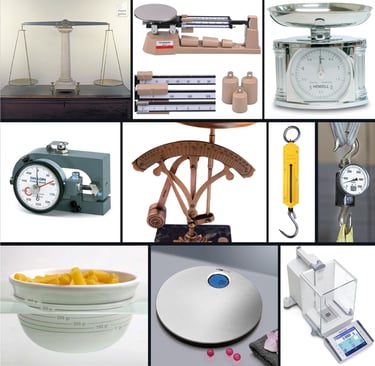
Some examples of a balance scale, triple beam balance, spring scale, force gauge, pendulum scale, hanging scale, hydraulic scale, water weighing scale and digital scales.


Some examples of a balance scale, triple beam balance, spring scale, force gauge, pendulum scale, hanging scale, hydraulic scale, water weighing scale and digital scales.
Archimedes' Principle ——
Focused on a traditional weighing system, my intention was to use this uncommon but equally functional system, to develop a product that could be used at home and show the potential of this physical principle. As a result, my choice was based on the Archimedes’ principle, which stays that any object, totally or partially immersed in a fluid or liquid, is buoyed up by a force equal to the weight of the fluid displaced by the object.
Archimedes' Principle ——
Focused on a traditional weighing system, my intention was to use this uncommon but equally functional system, to develop a product that could be used at home and show the potential of this physical principle. As a result, my choice was based on the Archimedes’ principle, which stays that any object, totally or partially immersed in a fluid or liquid, is buoyed up by a force equal to the weight of the fluid displaced by the object.
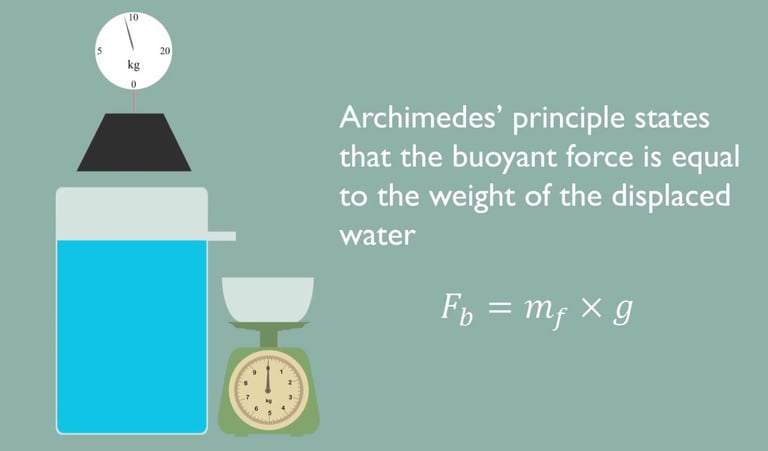

Inspiration ——
Unfortunately, there are very few products on the market that use this principle to weigh objects in domestic environments. Although on the one hand this can be seen as a disadvantage, on the other hand, this offers a wide range of possibilities to explore. First, focused on technology and its uses, and secondly, on product shapes and sizes.
Inspiration ——
Unfortunately, there are very few products on the market that use this principle to weigh objects in domestic environments. Although on the one hand this can be seen as a disadvantage, on the other hand, this offers a wide range of possibilities to explore. First, focused on technology and its uses, and secondly, on product shapes and sizes.

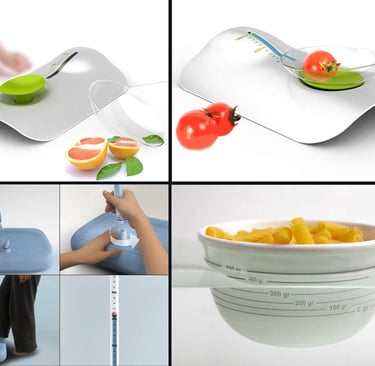
'Water Scale' (concept) by Muzaffer Kocer & Ayca Guven, 'Water Climb' (concept) by Jaeyoon Park, Dajeong Kim & Jeong Heo, and 'Weighing bowl' by Acquacalda.


'Water Scale' (concept) by Muzaffer Kocer & Ayca Guven, 'Water Climb' (concept) by Jaeyoon Park, Dajeong Kim & Jeong Heo, and 'Weighing bowl' by Acquacalda.
Eureka — is the end result of a modern scale based on an ancient mechanism, the Archimedes principle.
Outcome ——
Eureka — is the end result of a modern scale based on an ancient mechanism, the Archimedes principle.
Outcome ——
Today, digital scales offer several advantages such as high accuracy, speed, easy handling and small dimensions. Obviously, competing against these characteristics is difficult and this is the main reason why traditional scales are being displaced.
Created to claim the use of traditional measurement systems, Eureka aims to compete against digital scales, thanks to its ingenuity. What characterizes this product is not exactly its accuracy, which limit is set to 100g, but its design and the way it is used. Defined by a simple and functional minimalist design, this scale allows weighing objects with water as if it was a game. Eureka is easy to use and clean, it provides different colors, and its user-friendly design has been thought for users of different ages, including children. Capable of weighing objects up to 2 kg, it is a perfect scale for use in the kitchen.
Today, digital scales offer several advantages such as high accuracy, speed, easy handling and small dimensions. Obviously, competing against these characteristics is difficult and this is the main reason why traditional scales are being displaced.
Created to claim the use of traditional measurement systems, Eureka aims to compete against digital scales, thanks to its ingenuity. What characterizes this product is not exactly its accuracy, which limit is set to 100g, but its design and the way it is used. Defined by a simple and functional minimalist design, this scale allows weighing objects with water as if it was a game. Eureka is easy to use and clean, it provides different colors, and its user-friendly design has been thought for users of different ages, including children. Capable of weighing objects up to 2 kg, it is a perfect scale for use in the kitchen.
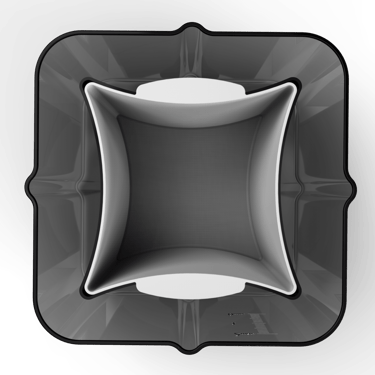
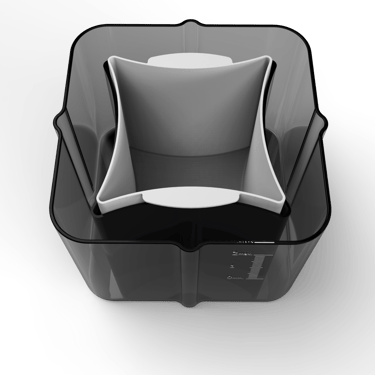
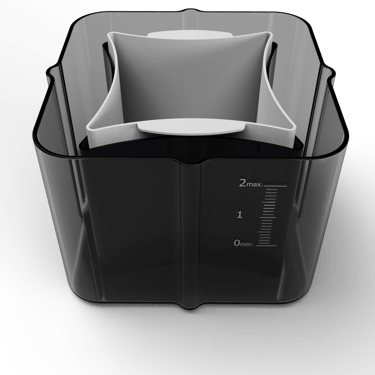
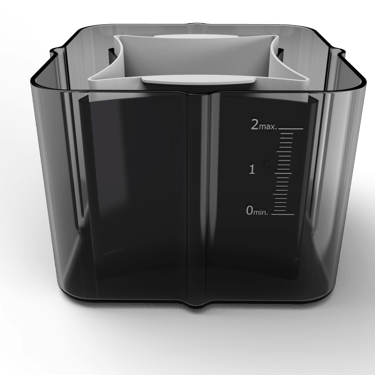

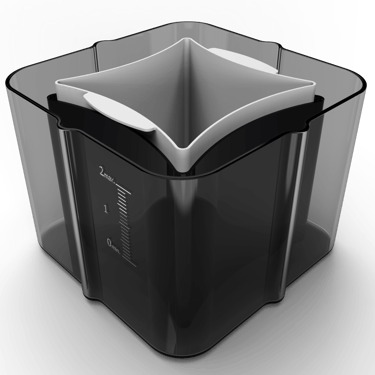
Components ——
Eureka consists of 3 containers, each designed for a specific purpose. External container (1) serves to contain the water necessary for its operation. Intermediate container (2), was strategically designed to fit on the rails of the container (1) to be slipped vertically when containing weight. Internal container (3), was added in order to provide another container that could be easy to remove and that was not in contact with water. This avoids unwanted water splashing every time the user pretends to extract the products that have been weighed..
Components ——
Eureka consists of 3 containers, each designed for a specific purpose. External container (1) serves to contain the water necessary for its operation. Intermediate container (2), was strategically designed to fit on the rails of the container (1) to be slipped vertically when containing weight. Internal container (3), was added in order to provide another container that could be easy to remove and that was not in contact with water. This avoids unwanted water splashing every time the user pretends to extract the products that have been weighed..

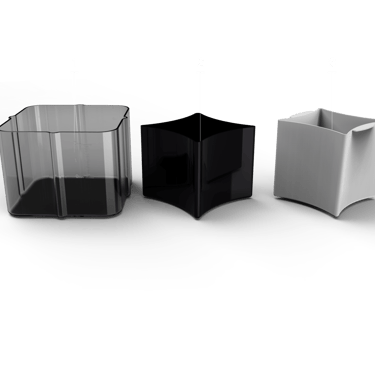
Operating Mode ——
To start using this scale, it is recommended to follow next steps:
Rotate the container (1) and (2) to make align their respective rails. This allows to prepare the sliding mechanism of the scale for the proper vertical movement.
Place the container (3) inside the previous ones (1, 2).
Place all 3 containers on a horizontal surface like a kitchen top. Then pour water into the container (1) until it reaches zero mark (2.8L of water is needed approx.). In this way the scale is calibrated and ready to use.
To weigh a product, place it in the container (3). The correct weight of the product will be shown by what the water level is marking.
Once weighed, remove the product by taking out the container (3), or remove this last container when required (mainly for bulk products).
Operating Mode ——
To start using this scale, it is recommended to follow next steps:
Rotate the container (1) and (2) to make align their respective rails. This allows to prepare the sliding mechanism of the scale for the proper vertical movement.
Place the container (3) inside the previous ones (1, 2).
Place all 3 containers on a horizontal surface like a kitchen top. Then pour water into the container (1) until it reaches zero mark (2.8L of water is needed approx.). In this way the scale is calibrated and ready to use.
To weigh a product, place it in the container (3). The correct weight of the product will be shown by what the water level is marking.
Once weighed, remove the product by taking out the container (3), or remove this last container when required (mainly for bulk products).
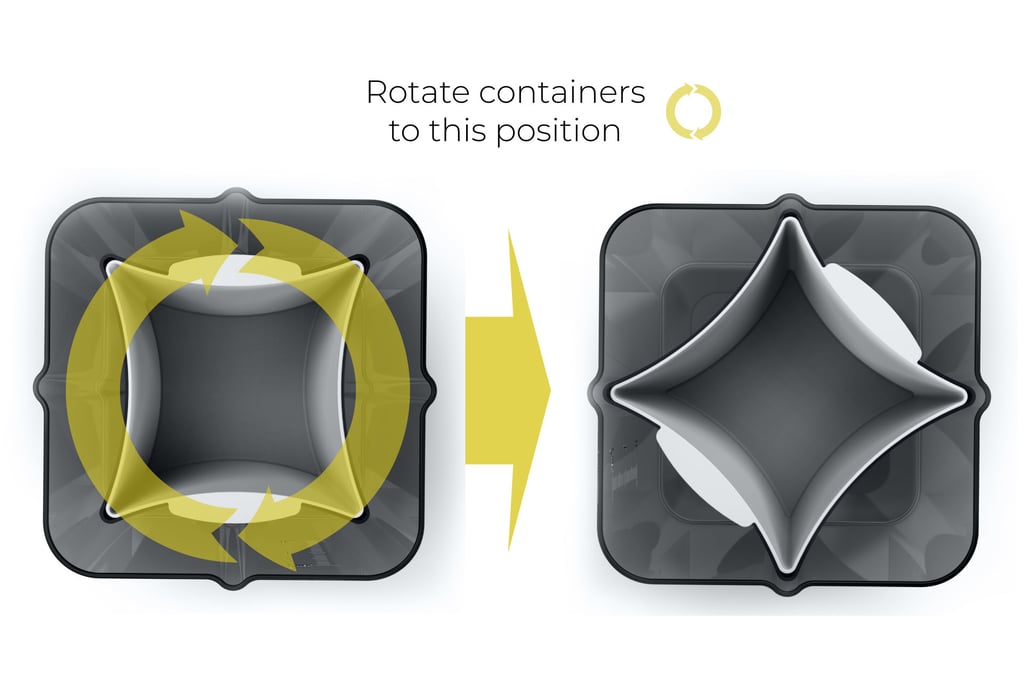
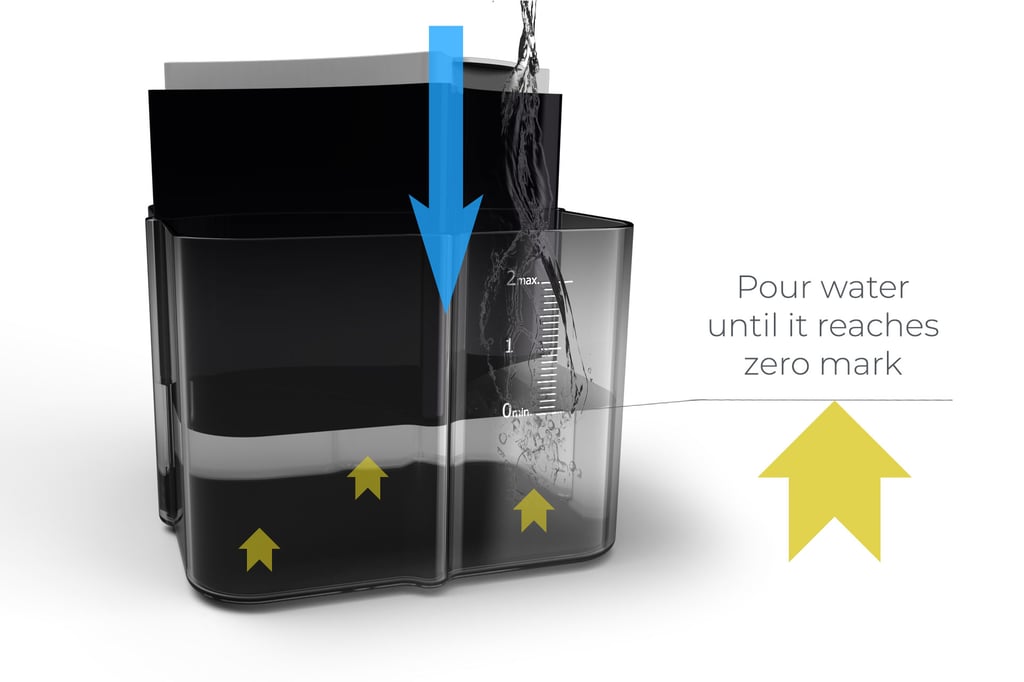
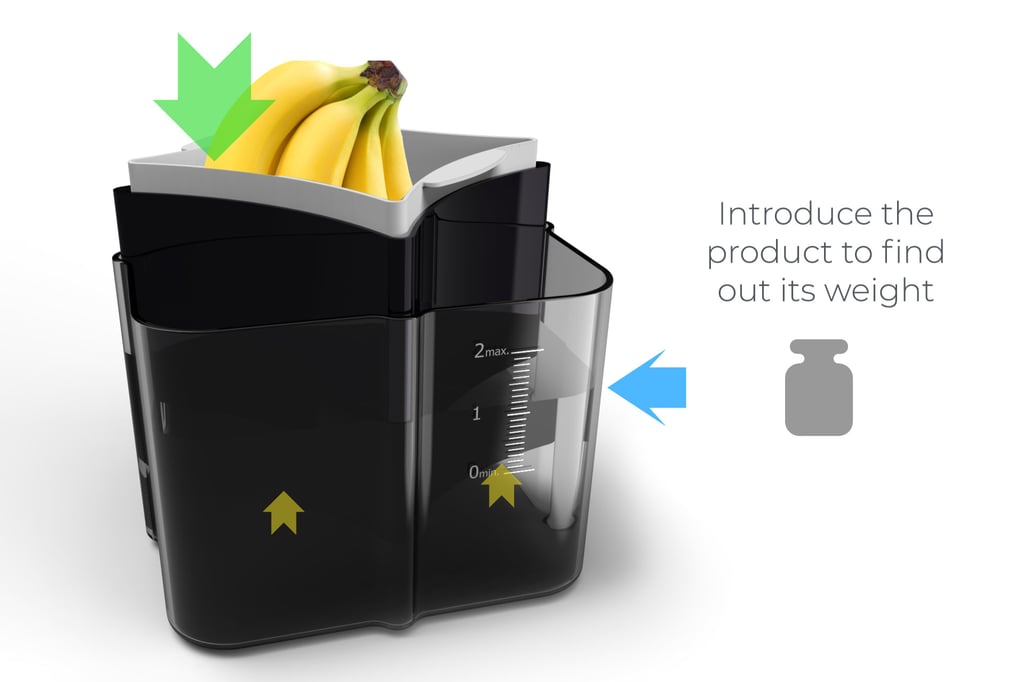













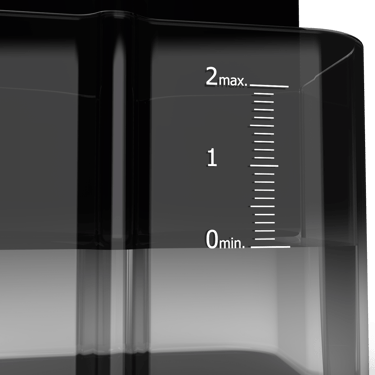
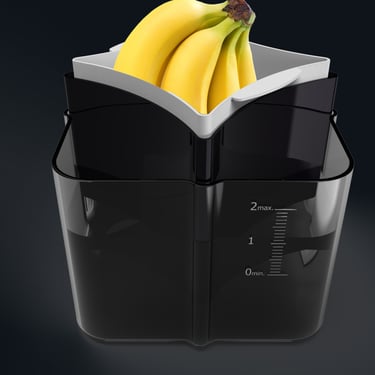
CMF ——
Regarding the colors, materials and finishes (CMF) of this product, Eureka was designed with the intention of using materials such as PC for its external (1) and intermediate (2) containers. However, it is necessary to mention that while the container (2) must be opaque for a better contrast with the water, the container (1) must be transparent to visualize the level of water, necessary to operate this product correctly. For its internal container (3), it was thought to use silicone since it is flexible and durable, it is also one of the most advisable materials for products that are in contact with food.
CMF ——
Regarding the colors, materials and finishes (CMF) of this product, Eureka was designed with the intention of using materials such as PC for its external (1) and intermediate (2) containers. However, it is necessary to mention that while the container (2) must be opaque for a better contrast with the water, the container (1) must be transparent to visualize the level of water, necessary to operate this product correctly. For its internal container (3), it was thought to use silicone since it is flexible and durable, it is also one of the most advisable materials for products that are in contact with food.

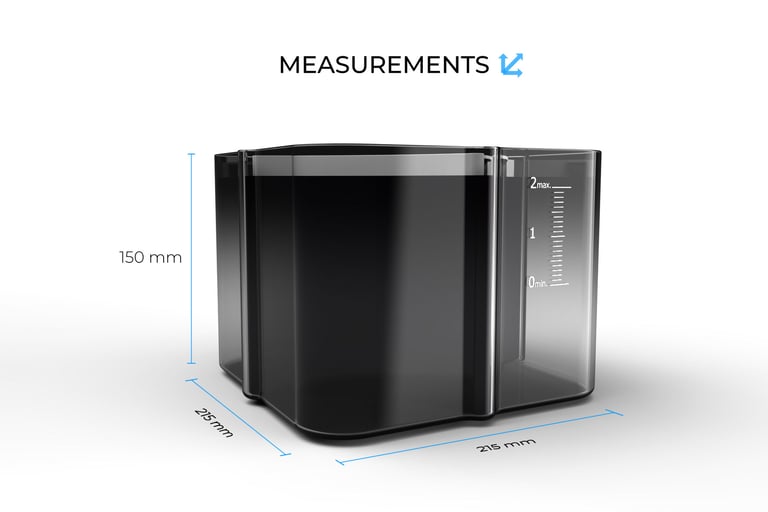


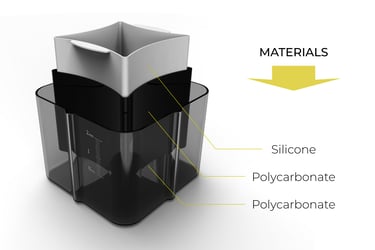



The color selection can be as varied as possible, as long as the external container (1) remains transparent for the reasons explained above.
When it comes to Eureka finishes, all containers must have a smooth finish. In the case of containers (1) and (2), this would reduce the coefficient of friction between them during the weighing process, and thus provide more accurate data. The finish of the container (3), on the other hand, is recommended to be smooth to provide better cleaning after use, as it would be continuously exposed to food.
The color selection can be as varied as possible, as long as the external container (1) remains transparent for the reasons explained above.
When it comes to Eureka finishes, all containers must have a smooth finish. In the case of containers (1) and (2), this would reduce the coefficient of friction between them during the weighing process, and thus provide more accurate data. The finish of the container (3), on the other hand, is recommended to be smooth to provide better cleaning after use, as it would be continuously exposed to food.
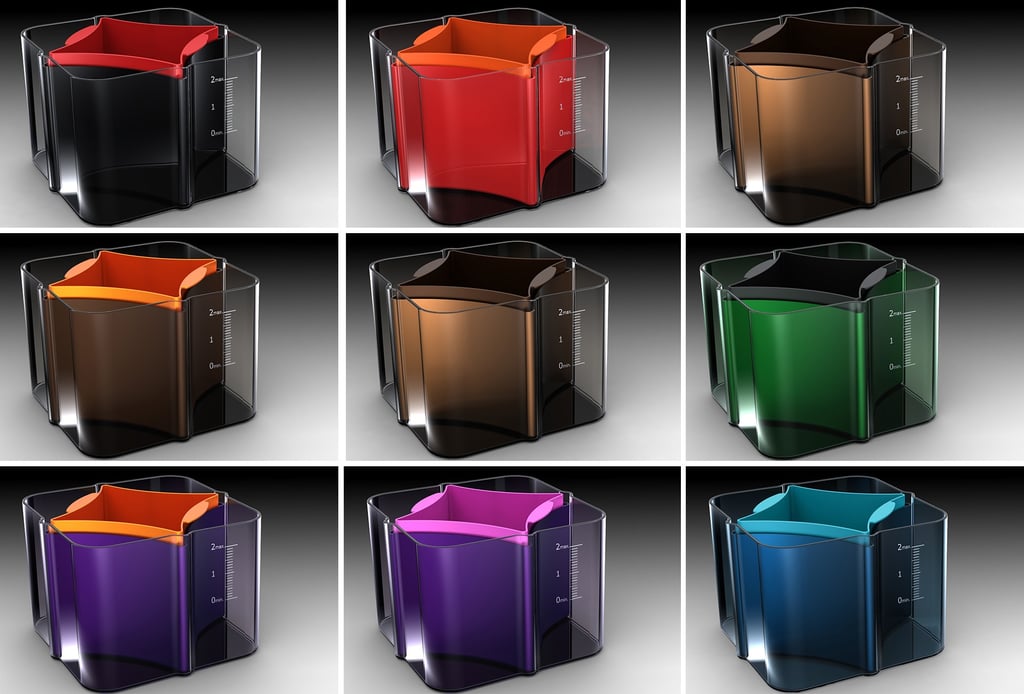




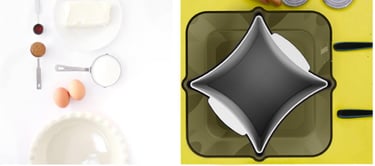
Copyright © 2025. Vasyl Pavlyuchok. All Rights Reserved.
